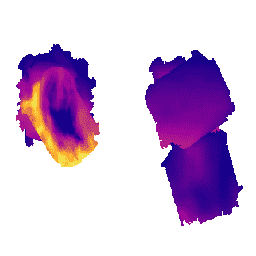
- Dostępność zbioru danych
- 2021-07-30T00:00:00Z–2023-10-13T00:00:00Z
- Dostawca zbioru danych
- Environmental Defense Fund - MethaneSAT
- Tagi
Opis
Model emisji obszarowych jest w fazie rozwoju i nie reprezentuje produktu końcowego.
Ten zbiór danych zawiera rozproszone przestrzennie strumienie emisji metanu (kg/godz.) na podstawie pomiarów z lotów MethaneAIR, które koncentrują się na regionach wydobycia ropy naftowej i gazu ziemnego w Stanach Zjednoczonych. Całkowitą emisję na obszarze objętym badaniem uzyskuje się przez zsumowanie wartości pikseli.
Metan to silny gaz cieplarniany, który w ciągu pierwszych 20 lat po przedostaniu się do atmosfery ma ponad 80 razy większy potencjał ocieplenia niż dwutlenek węgla. Co najmniej 30% obecnego globalnego ocieplenia jest spowodowane metanem pochodzącym z działalności człowieka. Ograniczenie emisji metanu związanej z działalnością człowieka – w tym możliwych do uniknięcia emisji z operacji naftowych i gazowych, rolnictwa i gospodarki odpadami – to najszybszy sposób na spowolnienie tempa globalnego ocieplenia.
Emisje z obszaru są szacowane na podstawie zaobserwowanych wartości XCH4 przy użyciu geostatystycznego modelu odwrotnego (patrz zbiór danych „MethaneAIR L4 Area Sources”). Do powiązania zmian w obserwowanych wartościach XCH4 z potencjalnymi źródłami po stronie nawietrznej używamy modelu transportu atmosferycznego – stochastycznego modelu transportu lagranżowskiego z odwróconym czasem „STILT” [Lin i in. (2003), Fasoli i in. (2018)], który jest zasilany danymi meteorologicznymi z modelu NOAA High-Resolution Rapid Refresh Model „HRRR”. Stosujemy podejście hierarchiczne, aby oddzielić warianty XCH4 wynikające z emisji obszarowych od tych, które są spowodowane emisjami z źródeł punktowych lub napływem przez granicę domeny (stężenie „tła”). Emisje ze źródeł punktowych są określane indywidualnie (patrz zbiór danych „MethaneAIR L4 Point Sources”) i wcześniej odejmowane od zaobserwowanego XCH4. Następnie do oszacowania dopływu XCH4 w domenie granicznej używany jest model odwrotny. Na koniec emisje obszarowe są szacowane za pomocą geostatystycznego modelu odwrotnego z wymuszonym rozwiązaniem nieujemnym. Łączna emisja to suma emisji z obszarów i źródeł punktowych.
Ten zbiór danych został wygenerowany na podstawie pomiarów MethaneAIR wykonanych podczas lotów między 30 lipca 2021 r. a 13 października 2023 r. MethaneAIR to powietrzny prekursor misji satelitarnej MethaneSAT, zarządzanej przez MethaneSAT LLC, podmiot zależny w całości należący do Environmental Defense Fund. Strumienie emisji metanu zostały wygenerowane przy użyciu geostatystycznego modelu odwrotnego, który jest wyspecjalizowany w wykorzystywaniu wysokiej rozdzielczości przestrzennej, szerokiego zasięgu przestrzennego i wysokiej precyzji danych MethaneAIR. Nie wszystkie produkty danych są dostępne w przypadku wszystkich lotów.
Więcej informacji o przyrządzie MethaneAIR, jego kalibracji i wykrywaniu emisji znajdziesz w ostatnich publikacjach Loughner i in. (2021), Staebell i in. (2021), Conway i in. (2023), Chulakadabba i in. (2023), Abbadi i in. (2023), Omara i in. (2023) oraz Miller i in. (2023).
Więcej informacji o projekcie możesz uzyskać od dostawcy danych, klikając ten link: https://www.methanesat.org/contact/
Pasma
Pasma
| Nazwa | Jednostki | Minimum | Maks. | Rozmiar piksela | Opis |
|---|---|---|---|---|---|
flux |
kg/h/km^2 | 0* | 28.3* | 1000 metrów | Emisje metanu możliwe do śledzenia na obszarze 1 km². |
Właściwości obrazu
Właściwości obrazu
| Nazwa | Typ | Opis |
|---|---|---|
| flight_id | CIĄG ZNAKÓW | Wyszukaj numer lotu. |
| Basin | CIĄG ZNAKÓW | basen ropy naftowej i gazu (np. Permian) lub obszar zainteresowania (np. Nowy Jork). |
| time_coverage_start | CIĄG ZNAKÓW | Godzina rozpoczęcia zbierania danych w formacie RRRR-MM-DDThh:mm:ssZ (ISO 8601). |
| time_coverage_end | CIĄG ZNAKÓW | Godzina zakończenia zbierania danych w formacie RRRR-MM-DDThh:mm:ssZ (ISO 8601). |
| processing_id | CIĄG ZNAKÓW | (wewnętrzny) Identyfikator przebiegu przetwarzania, który reprezentuje obliczenia, które doprowadziły do powstania cech. Nie jest to atrybut opisujący lot, ale potok przetwarzania. |
| area_source_total_kg_hr | PRZ | Łączna wartość emisji obszarowych dla tego lotu w kg/godz. Brakujące wartości są oznaczone jako -1. |
Warunki korzystania z usługi
Warunki korzystania z usługi
Korzystanie z tych danych podlega Warunkom licencji na treści MethaneSAT.
Cytaty
Chulakadabba, A., Sargent, M., Lauvaux, T., Benmergui, J. S., Franklin, J. E., Chan Miller, C., Wilzewski, J. S., Roche, S., Conway, E., Souri, A. H., Sun, K., Luo, B., Hawthrone, J., Samra, J., Daube, B. C., Liu, X., Chance, K., Li, Y., Gautam, R., Omara, M., Rutherford, J. S., Sherwin, E. D., Brandt, A., i Wofsy, S. C. 2023 r. Methane point source quantification using MethaneAIR: a new airborne imaging spectrometer, Atmos. Meas. Tech., 16, 5771-5785. doi:10.5194/amt-16-5771-2023,
Odkrywanie za pomocą Earth Engine
Edytor kodu (JavaScript)
var dataset = ee.ImageCollection("EDF/MethaneSAT/MethaneAIR/L4area"); var fluxVisParams = { min: 0, max: 18, palette: ['#070088','#a3069b','#cc4e64','#ffa826','#edfb59'], }; // Center on one of the available areas of interests. Map.setCenter(-102.5, 31.85, 8); Map.addLayer(dataset, fluxVisParams, 'Methane area sources flux');
